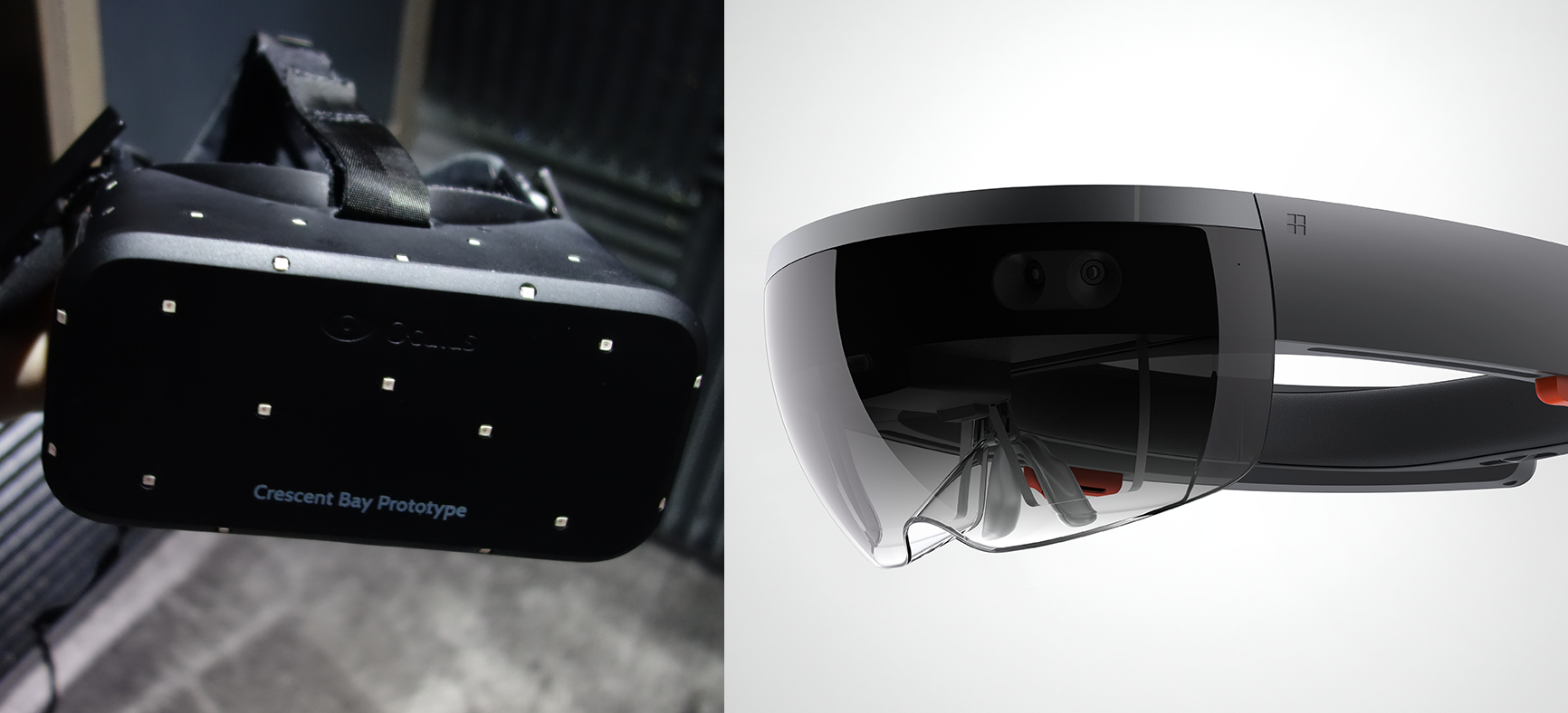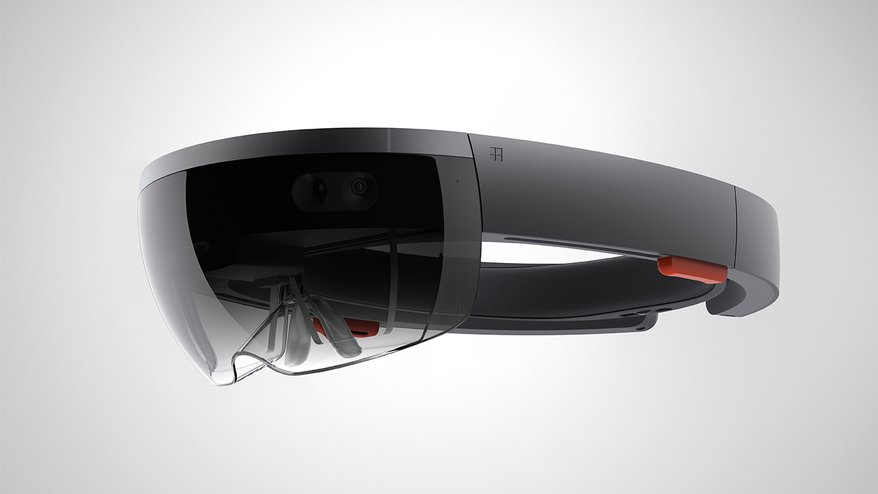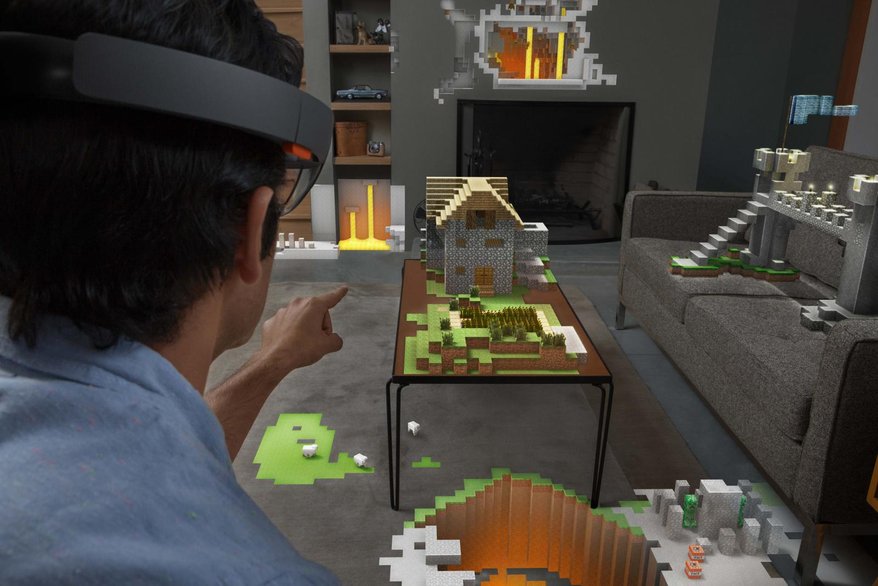Head 2 Head: Oculus Rift vs. HoloLens

We’ve tried HoloLens and Crescent Bay—our thoughts on both headsets
With Microsoft now entrenched in the headset realm with HoloLens , many of you might be wondering how it stacks up against Oculus VR’s Oculus Rift. After all, both are head-mounted displays. Still, while they have their similarities, they are also quite different.
Whereas a virtual-reality headset aims to pull you into a virtual world, Microsoft has said many times that its augmented reality headset is content with keeping you in the real world, but simply wants to inject your life with holograms. We’ve had the rare chance of trying out both Microsoft’s HoloLens development kit and Oculus VR’s newest Crescent Bay headset. Which one do we think is better? While consumer versions aren’t out for either device, we thought we would weigh the pros and cons of each via five categories below.

Left to right: Oculus Rift (Crescent Bay), Microsoft HoloLens prototype
Keep in mind that as neither headset has had its official release, our opinions are subject to change. Also, we haven’t included unknown categories such as price, etc.
Round 1: Design
While both products are likely several months away from release, we know slightly more about the consumer version of the Oculus Rift than than the HoloLens. Rumor is that Crescent Bay, which Oculus says is a prototype of what its first consumer version might look like, is using a 2560x1440-resolution panel, and we suspect the consumer version will be in that vicinity as well. When we asked Oculus VR founder Nate Mitchell what refresh rate we can expect to see for the consumer headset, he told us, “At least 90hz.” In addition, we suspect the consumer version of Oculus Rift will support roughly a 100-degree field of view (give or take a few degrees). We also know that there will be a SKU that offers 3D positional audio that will tie in well to the Rift’s excellent stereoscopic 3D visuals. We also know that, unless something changes, CV1 of the Oculus Rift will rely on an external camera for positional head tracking, which Microsoft’s HoloLens will not use. And because the Oculus Rift obstructs your view of the “outside world,” Oculus maintains that the Rift is intended for seated experiences at the moment.
A grandmother is blown away by the Oculus Rift
This isn’t the case with HoloLens, however. Because you can see the virtual along with the real, Microsoft is fine with you walking around with the headset on. When we tried out an early HoloLens prototype headset, it was wired and also had a connected chest strap, but Microsoft says that the final version will be wireless. Unlike the Oculus Rift, which needs to be plugged into a PC, the HoloLens will essentially be a self-contained computer running Windows 10. It will have its own CPU, GPU, and a new holographic processing unit (HPU) that will tie everything together.
Keep up to date with the most important stories and the best deals, as picked by the PC Gamer team.

A prototype for Microsoft's HoloLens
HoloLens does have some similarities to the Oculus Rift, however—it will support stereoscopic 3D and have speakers that provide positional audio. Other HoloLens features include an integrated depth sensor, finger-swiping gesture support, and a built-in mic. Some of that could be coming to the Oculus Rift as well, especially considering Oculus acquired camera/hand tracking company Nimble VR , so we’ll have to wait and see if the two headsets become more similar over time.
A big difference between the two headsets in their current states is that the virtual field of view is smaller on Microsoft’s headset. There's also no definitive word on how sharp the final version of HoloLens will be. Microsoft simply told us “HD,” which indicates at least a 720P display. If what we saw at Microsoft’s Windows 10 event was any indication of what the resolution might look like for the consumer version, we’d say were in pretty good shape, as we thought it looked pretty sharp.
Because there’s so much up in the air at this point, with designs and specs always changing, We can’t award a winner in this category.
Winner: Too early to predict
Round 2: Immersion
Both headsets are trying to sell you on immersion, but which one is more immersive? They offer two very different kinds of experiences. With the HoloLens, Microsoft isn’t trying to shield you from understanding where you are, but it does an excellent job of representing virtual things in your room that aren’t really there.
Microsoft HoloLens possibilities video
Still, we’d have to give this nod to the Rift, because if it’s pulled off correctly, it can actually do a pretty great job of selling you on the fact that you’re in a different universe altogether. We’re confident virtual tourism will work better with the Rift, and that games will also be more intense and scarier with Oculus’s offering. When we tried on the Crescent Bay demo at GDC 2014, there was a demo where we saw a giant T-Rex approach us and it felt like it could really bite off our heads (à la Jurassic Park lawyer scene) if he really wanted to. It was kind of unsettling. Plus, the Rift currently offers a more encompassing field of view.
Winner: Oculus Rift
Round 3: Productivity
With Facebook purchasing Oculus for 2 billion dollars, we’re sure social media, video chat, and such will be big components of the headset, but considering you can see the virtual along with the real with Microsoft’s solution, we’re going with HoloLens for productivity potential at this point.
At Microsoft’s Windows 10 press conference, the company brought us into a room, asked us to put on HoloLens and fix an electrical wall socket with real, physical tools. Using Skype, the person on the other end could see what we we were seeing and they could draw on their touchscreen to point out problem areas that needed to be addressed. This worked about as well as someone looking over our shoulder in real life.

We can see this being used to fix cars or even people, and can easily imagine HoloLens being used in the ER or to help soldiers detect landmines on the battlefield in real time.
In addition to this, we know that HoloLens will support finger gestures (though we could also see Oculus adding this to its headsets later on). This will allow you to use Microsoft’s HoloStudio program to create 3D objects, which you can later send to a 3D printer. Microsoft says it’s the best print preview for 3D printing out there, and it’s a pretty convincing argument. With HoloLens, the lines between the real and digital will become blurrier.
Winner: HoloLens
Round 4: Gaming
We’re still not entirely sure what games to expect from the Oculus Rift. Right now we’re in a stage where lots of traditional first-person games are being ported over, but Oculus has said time and time again that the best VR games will have to be tailor made for VR, and we’re inclined to agree with them. That is because locomotion is currently an issue, that is the queasiness you experience when your eyes think your body is moving but your brain does not. And there isn’t yet a silver bullet controller that will help you best interact in these VR worlds.

There are perhaps even more questions for gaming on HoloLens. We could see I-spy games being really popular around the house, and perhaps we can see FPS games that have us blasting aliens that come in from the kitchen, but at the same time, Microsoft hasn’t said how easy/hard the programming for any of this would be.
From the information we have, it seems much easier to program games for Oculus, since developers won’t have to deal with real-world variances, etc. The HoloLens does have mobility going for it, though.You should be able to run around the house, and this could open up new gameplay opportunities. While we’re confident that some cool casual games could come out of this, at this point we’re inclined to say the bigger AAA games will be on Oculus.
Winner: Oculus Rift
Round 5: Entertainment
With a bunch of VR documentaries already announced, including one from legendary nature documentary producer David Attenborough, it’s going to be tough to beat the Rift here. We also expect to see more videos and movies created for VR. Plus, much of the porn industry is also behind VR as well, so there’s that…
Zero Point VR documentary trailer
We think the wider viewing angle and all-encompassing approach that Oculus brings to the table help it trump HoloLens for entertainment, at least for now.
Winner: Oculus Rift
Conclusion:
We know Oculus won three out of the five categories here, but really, the two devices aim to serve different purposes. Is there room for both headsets? Only time will tell. Perhaps one day we might see an amalgamation headset that combines elements of VR and AR. Conversely, both of these headsets still have a lot to prove and if they aren’t executed well, could both become shovelware.
If we had to give the overall momentum to one solution over the other, however, we’d have to give Oculus Rift the advantage. At this point, people can relate more easilty to the idea of VR. Admittedly, it has the benefit of getting an earlier start. And with Oculus VR doing a good job embracing the open-source community, there are currently more people/developers behind its headset at the moment.
Considering both are rumored to release this year, we're hoping we won’t have to wait too much longer to see which one makes a bigger splash when they officially arrive.

